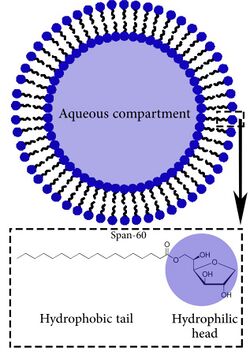Biology:Niosome

Niosomes are vesicles composed of non-ionic surfactants, incorporating cholesterol as an excipient.[1] Niosomes are utilized for drug delivery to specific sites to achieve desired therapeutic effects.[2] Structurally, niosomes are similar to liposomes as both consist of a lipid bilayer. However, niosomes are more stable than liposomes during formation processes and storage.[3] Niosomes trap hydrophilic and lipophilic drugs, either in an aqueous compartment (for hydrophilic drugs)[4] or in a vesicular membrane compartment composed of lipid material (for lipophilic drugs).[3]
Structure
Niosomes are microscopic lamellar structures formed by non-ionic surfactants and cholesterol. They exhibit a bilayer structure, with hydrophilic ends facing outward and hydrophobic ends facing inward. Their unique structure makes them ideal for diverse applications, notably in drug delivery systems. Niosomes excel in encapsulating both hydrophilic and hydrophobic drugs, enhancing drug stability and bioavailability. They are adaptable for tailored drug release and have garnered interest across pharmaceuticals, cosmetics, and agriculture for their biocompatibility and versatile properties.[5]
Methods of preparation
Various methods used to prepare liposomes are also suitable for niosome preparation,[1] such as the ether injection method, the handshaking method, the reverse phase evaporation method, the trans-membrane pH gradient method, the "bubble" method, the microfluidization method, formation from proteasomes,[5] the thin-film hydration method, the heating method, the freeze and thaw method, and the dehydration-rehydration method.
Uses
Niosomes are used as biodegradable and non-immunogenic drug delivery compounds,[6] as they have a low toxicity risk in biological systems.[7] They can also be used to entrap hydrophilic pharmaceuticals within aqueous compartments[4] or lipophilic drugs into vesicular bilayer membranes. Niosomes shield drug molecules from the biological environment, which can be utilized to improve the therapeutic performance of various drug molecules. Additionally, they can be used in a sustained drug delivery system to more directly affect target cells and delay clearance from circulation.[7][4] Niosomes are used in a variety of applications, including gene delivery,[8][9] drug targeting,[4] antineoplastic treatment,[10][11] delivery of peptide drugs, carriers for hemoglobin, transdermal drug delivery systems,[12] and cosmetics.[13] They are also being studied for their potential use as a treatment for different forms of leishmaniasis[14]
References
- ↑ Jump up to: 1.0 1.1 1.2 "Nano-niosomes as nanoscale drug delivery systems: an illustrated review". Journal of Controlled Release 185: 22–36. July 2014. doi:10.1016/j.jconrel.2014.04.015. PMID 24747765.
- ↑ "Drug Delivery Systems (definition)". http://www.reference.md/files/D016/mD016503.html.
- ↑ Jump up to: 3.0 3.1 "Advances of Non-Ionic Surfactant Vesicles (Niosomes) and Their Application in Drug Delivery". Pharmaceutics 11 (2): 55. January 2019. doi:10.3390/pharmaceutics11020055. PMID 30700021.
- ↑ Jump up to: 4.0 4.1 4.2 4.3 "Niosome: A future of targeted drug delivery systems". Journal of Advanced Pharmaceutical Technology & Research 1 (4): 374–380. October 2010. doi:10.4103/0110-5558.76435. PMID 22247876.
- ↑ Jump up to: 5.0 5.1 "Niosomes". Pharmaxchange. 26 December 2010. https://pharmaxchange.info/2010/12/niosomes/#more-136.
- ↑ "Chapter 5: Mitochondria-targeted drug delivery in neurodegenerative diseases: 5.3 Niosomes" (in en). Delivery of Drugs. Elsevier. 2020. pp. 97–117 (105–106). doi:10.1016/B978-0-12-817776-1.00005-5. ISBN 978-0-12-817776-1. https://linkinghub.elsevier.com/retrieve/pii/C2018002191X.
- ↑ Jump up to: 7.0 7.1 "Chapter 6: Drug delivery systems: 6.8 Niosomes" (in en). Strategies to Modify the Drug Release from Pharmaceutical Systems. Elsevier. 2015. pp. 87–194 (147–150). doi:10.1016/B978-0-08-100092-2.00006-0. ISBN 978-0-08-100092-2. https://linkinghub.elsevier.com/retrieve/pii/C20140023428.
- ↑ "Nano-niosomes as nanoscale drug delivery systems: an illustrated review". Journal of Controlled Release 185: 22–36. July 2014. doi:10.1016/j.jconrel.2014.04.015. PMID 24747765.
- ↑ "A novel cationic niosome formulation for gene delivery to the retina". Journal of Controlled Release 174: 27–36. January 2014. doi:10.1016/j.jconrel.2013.11.004. PMID 24231407.
- ↑ Moghtaderi, Maryam; Sedaghatnia, Kamand; Bourbour, Mahsa; Fatemizadeh, Mahdi; Salehi Moghaddam, Zahra; Hejabi, Faranak; Heidari, Fatemeh; Quazi, Sameer et al. (2022-09-29). "Niosomes: a novel targeted drug delivery system for cancer" (in en). Medical Oncology 39 (12): 240. doi:10.1007/s12032-022-01836-3. ISSN 1559-131X. https://doi.org/10.1007/s12032-022-01836-3.
- ↑ Bashkeran, Thaaranni; Kamaruddin, Azlina Harun; Ngo, Trung Xuan; Suda, Kazuma; Umakoshi, Hiroshi; Watanabe, Nozomi; Nadzir, Masrina Mohd (2023-08-01). "Niosomes in cancer treatment: A focus on curcumin encapsulation". Heliyon 9 (8): e18710. doi:10.1016/j.heliyon.2023.e18710. ISSN 2405-8440. PMC 10428065. https://www.sciencedirect.com/science/article/pii/S2405844023059182.
- ↑ "Carriers/vesicles based approaches for penetration enhancement in transdermal drug delivery.". Latest Review 8 (1): 1–5. 2010. http://www.pharmainfo.net/keywords/niosomes.
- ↑ Handjani RM, Ribier A, Vanlerberghe G, Zabotto A, Griat J, "Cosmetic and pharmaceutical compositions containing niosomes and a water-soluble polyamide, and a process for preparing these compositions", US patent 4830857, issued 16 May 1989, assigned to L'Oréal
- ↑ "A Novel Niosomal Combination of Selenium Coupled with Glucantime against Leishmania tropica". The Korean Journal of Parasitology 57 (1): 1–8. February 2019. doi:10.3347/kjp.2019.57.1.1. PMID 30840792.
 |

